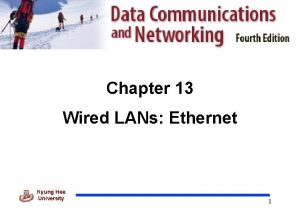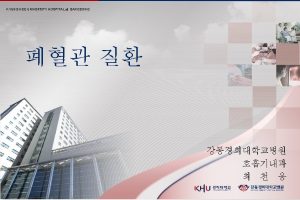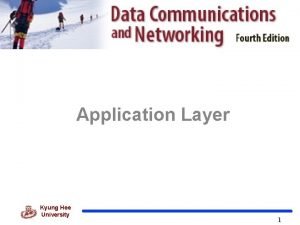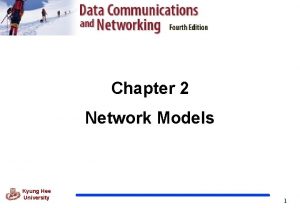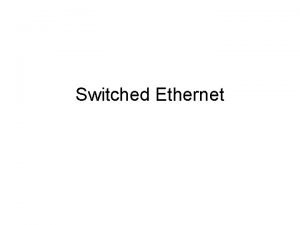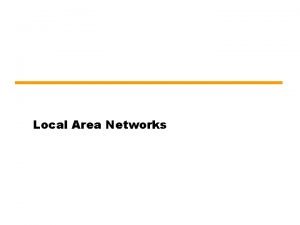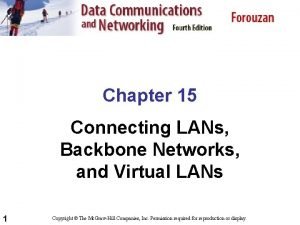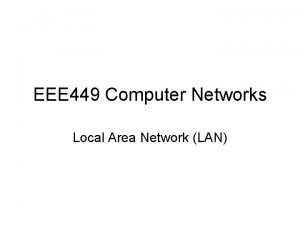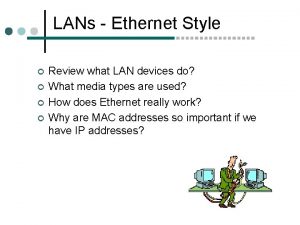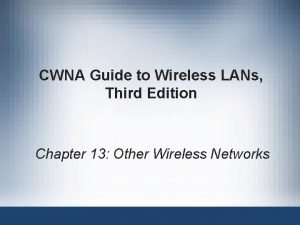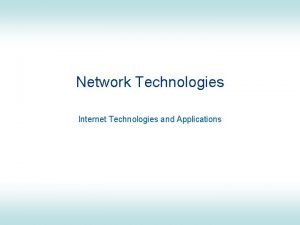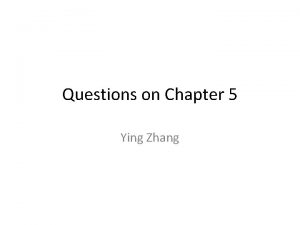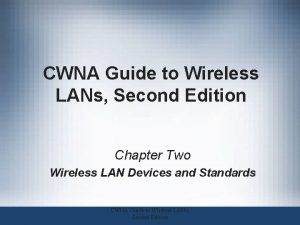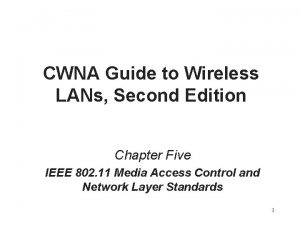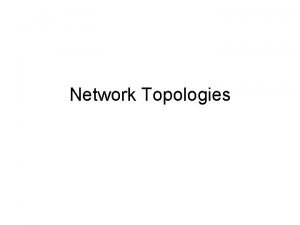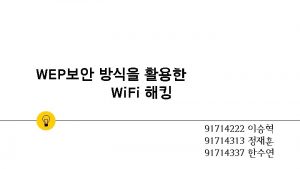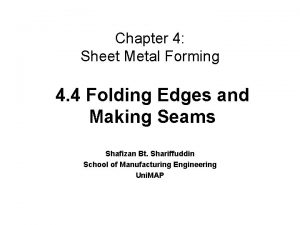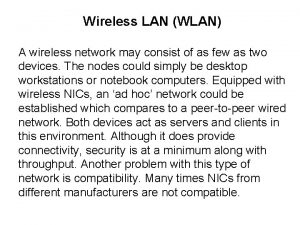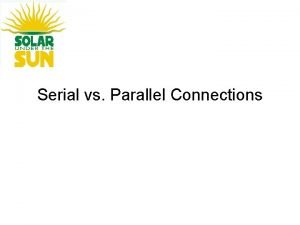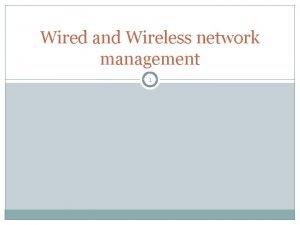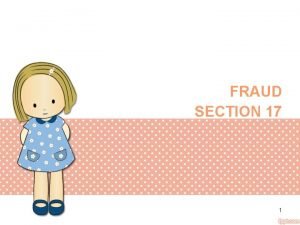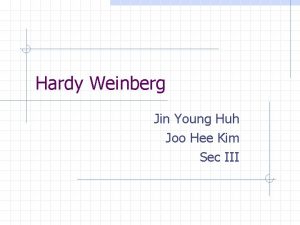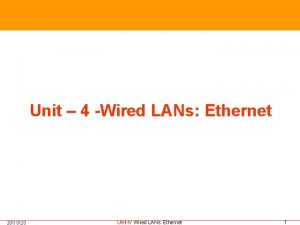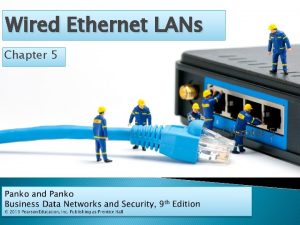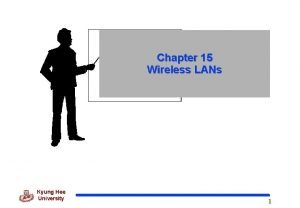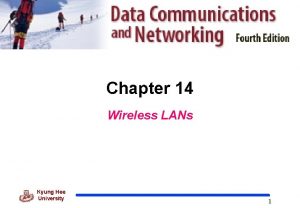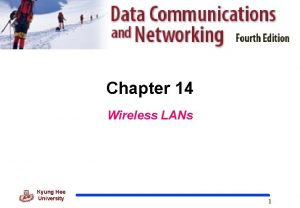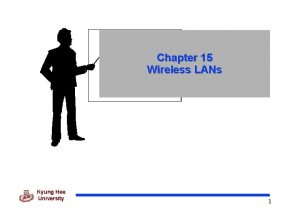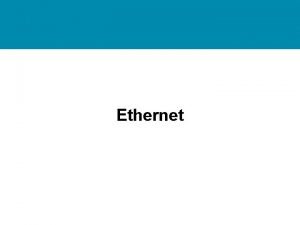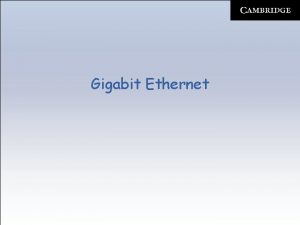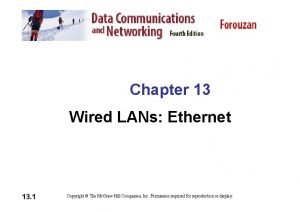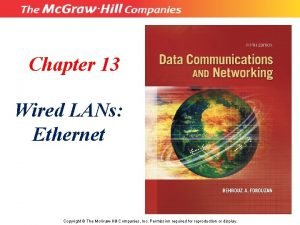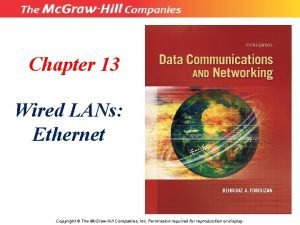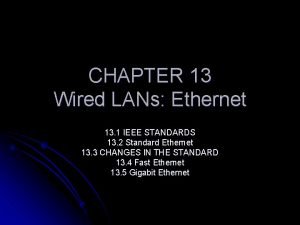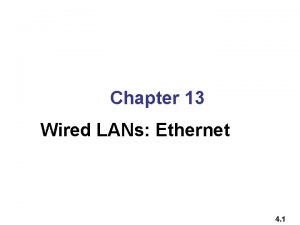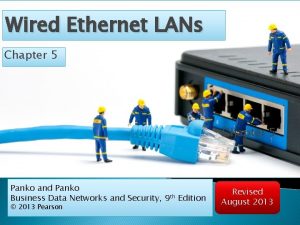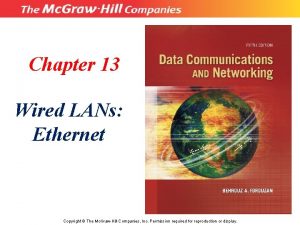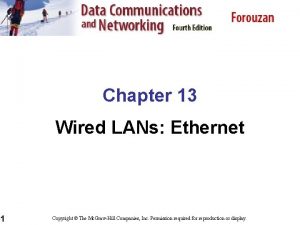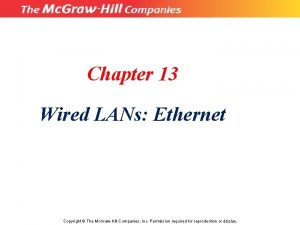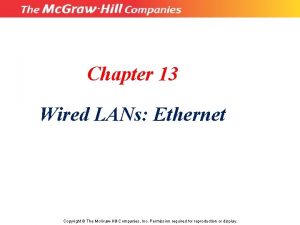Chapter 13 Wired LANs Ethernet Kyung Hee University













































- Slides: 45

Chapter 13 Wired LANs: Ethernet Kyung Hee University 1

13 -1 IEEE STANDARDS In 1985, the Computer Society of the IEEE started a project, called Project 802, to set standards to enable intercommunication among equipment from a variety of manufacturers. Project 802 is a way of specifying functions of the physical layer and the data link layer of major LAN protocols. Topics discussed in this section: Data Link Layer Physical Layer Kyung Hee University 2

IEEE Standards q The data link layer has subdivided into two sublayers; v. Logical link control (LLC) and media access control (MAC) Kyung Hee University Figure 13. 1 IEEE standard for LANs 3

IEEE Standards q Logical Link Control (LLC) v. Flow control, error control, and part of the framing duties are collected into the LLC. q. Media Access Control (MAC) v. MAC defines the specific access method for each LAN. v. MAC contains a No. of distinct modules. Kyung Hee University Figure 13. 2 HDLC frame compared with LLC and MAC frames 4

13 -2 STANDARD ETHERNET The original Ethernet was created in 1976 at Xerox’s Palo Alto Research Center (PARC). Since then, it has gone through four generations. We briefly discuss the Standard (or traditional) Ethernet in this section. Topics discussed in this section: MAC Sublayer Physical Layer Kyung Hee University 5

Standard Ethernet Figure 13. 3 Ethernet evolution through four generations Kyung Hee University 6

MAC Sublayer Figure 13. 4 802. 3 MAC frame • Preamble – 7 bytes of alternating 0 s and 1 s to alert the receiver and allow it to synchronize • Start Frame Delimiter (SFD) – 1 byte – 10101011 signals the beginning of a frame, last chance for synchronization – last 2 bits are 11 • Destination address (DA) – 6 bytes – contains the physical address of the destination station or stations • Source address (SA) – 6 bytes – contains the physical address of the sender • Length/type – it defines the length of the data field or to define upper-layer protocol using MAC frame • Data – data encapsulated from upper-layer protocols : 46 ~ 1500 bytes Kyung Hee– • CRC University CRC-32 7

MAC Sublayer Figure 13. 5 Minimum and maximum lengths Frame length: Minimum: 64 bytes (512 bits) Maximum: 1518 bytes (12, 144 bits) Kyung Hee University 8

MAC Addressing q Ethernet addresses in hexadecimal notation Figure 13. 6 Example of an Ethernet address in hexadecimal notation q Each station on an Ethernet network has its own network interface card (NIC) q NIC provides the station with a 6 -byte physical address Kyung Hee University 9

MAC Addressing v. The least significant bit of the first byte defines the type of address. Ø If the bit is 0, the address is unicast; otherwise, it is multicast. v. The broadcast destination address is a special case of the multicast address in which all bits are 1 s. Figure 13. 7 Unicast and multicast addresses Kyung Hee University 10

Access Method : CSMA/CD q Standard Ethernet uses 1 -presistent CSMA/CD q Slot time v Slot time = round-trip time + time required to send the jam sequence (10 Mbps Ethernet : 51. 2µs) q. Slot time & Maximum Network Length v. Max Length = Propagation speed x (slot time / 2) = (2 x 108 ) x (51. 2 x 10 -6 /2) = 5, 120 m v. Maximum Length of a traditional Ethernetwork is reduced to 2, 500 m, because of the delay time in repeater and interfaces, and the time required to send the jam sequence. Kyung Hee University 11

Physical layer Figure 13. 8 Categories of Standard Ethernet Kyung Hee University 12

Encoding and Decoding Figure 13. 9 Encoding in a Standard Ethernet implementation Kyung Hee University 13

10 Base-5 : Thick Ethernet q Thick Ethernet or Thicknet q Bus topology, external transceiver q Connection of a station to the medium using 10 Base 5 Figure 13. 10 10 Base 5 implementation Kyung Hee University 14

10 Base-2 : Thin Ethernet q Connection if stations to the medium using 10 Base 2 q Thin Ethernet or Cheapernet q Bus topology, internal transceiver or a point-to-point connection via an external transceiver Kyung Hee University Figure 13. 11 10 Base 2 implementation 15

10 Base-T : Twisted Pair Ethernet q Physical star topology q Stations connected to a hub with internal or external transceiver Kyung Hee University Figure 13. 12 10 Base-T implementation 16

10 Base-F : Fiber Ethernet q Fiber link Ethernet q Uses star topology to connect stations to a hub q Normally implemented with external transceiver having two pairs of fiber-optic cables connecting it to the hub. Figure 13. 13 10 Base-F implementation Kyung Hee University 17

Summary of Ethernet Table 13. 1 Summary of Standard Ethernet implementations Kyung Hee University 18

13 -3 CHANGES IN THE STANDARD The 10 -Mbps Standard Ethernet has gone through several changes before moving to the higher data rates. These changes actually opened the road to the evolution of the Ethernet to become compatible with other high-data-rate LANs. Topics discussed in this section: Bridged Ethernet Switched Ethernet Full-Duplex Ethernet Kyung Hee University 19

Bridged Ethernet q Raising the bandwidth q Separating collision domains Kyung Hee University 20

Raising the Bandwidth Figure 13. 14 Sharing bandwidth q A Network with and without a Bridge v 10/6 Mbps vs 10/12 Mbps in case that traffic is not going through the bridge Kyung Hee University 21

Separating Collision Domains Figure 13. 16 Collision domains in an unbridged network and a bridged network Kyung Hee University 22

Switched Ethernet q Bandwidth is shared only between the station and the switch (5 Mbps each) q N-port switch; Switched Ethernet Kyung Hee University 23

Full-Duplex Ethernet q A Limitation of 10 Base 5 and 10 Base 2 - half-duplex. q Evolution : switched Ethernet full duplex Switched Ethernet v 10 Base-T is always Full-duplex. q Full duplex mode increases the capacity of each domain from 10 to 20 Mpbs. Kyung Hee University 24

Full-Duplex Ethernet q Traditional Ethernet was designed as a connectionless protocol at the MAC sublayer. v No explicit flow control or error control to inform the sender that the frame has arrived at the destination without error. q For flow and error control in full-duplex switched Ethernet v No need for CSMA/CD, this functionality can be turned off. l Each link is a point-to-point dedicated path between the station and the switch. v Adding a sublayer called MAC Control between MAC sublayer and LLC sublayer Kyung Hee University 25

13 -4 FAST ETHERNET Fast Ethernet was designed to compete with LAN protocols such as FDDI or Fiber Channel. IEEE created Fast Ethernet under the name 802. 3 u. Fast Ethernet is backward-compatible with Standard Ethernet, but it can transmit data 10 times faster at a rate of 100 Mbps. Topics discussed in this section: MAC Sublayer Physical Layer Kyung Hee University 26

The goals of the Fast Ethernet q Upgrade the data rate to 100 Mbps. q Make it compatible with Standard Ethernet. q Keep the same 48 bit address. q Use the same frame format. q Keep the same minimum and maximum frame lengths. Kyung Hee University 27

MAC Sublayer - Fast Ethernet q Evolution from 10 to 100 Mpbs doesn’t change the MAC sublayer. q Access method is CSMA/CD v for the half-duplex approach, which is kept for backward compatibility; v for full duplex Fast Ethernet, there is no need for CSMA/CD q Frame format, minimum and maximum frame lengths, and addressing are the same. Kyung Hee University 28

Autonegotiation q Allowing two devices to negotiate the mode or data rate of operation. v To allow incompatible devices to connect to one another. For example, between 10 Mbps-device and 100 Mbpsdevice v To allow one device to have multiple capabilities v To allow a station to check a hub’s capabilities Kyung Hee University 29

Physical layer – Fast Ethernet Figure 13. 19 Fast Ethernet topology Kyung Hee University 30

Physical layer – Fast Ethernet Figure 13. 20 Fast Ethernet implementations Kyung Hee University 31

Physical layer – Fast Ethernet q Encoding/decoding – first performs block encoding using 4 B/5 B, then encoded using MLT-3 (multiline transmission, three level) Figure 13. 21 Encoding for Fast Ethernet implementation Kyung Hee University 32

Physical layer – Fast Ethernet Table 13. 2 Summary of Fast Ethernet implementations Kyung Hee University 33

13 -5 GIGABIT ETHERNET The need for an even higher data rate resulted in the design of the Gigabit Ethernet protocol (1000 Mbps). The IEEE committee calls the standard 802. 3 z. Topics discussed in this section: MAC Sublayer Physical Layer Ten-Gigabit Ethernet Kyung Hee University 34

The goals of the Gigabit Ethernet q Upgrade the data rate to 1 Gbps. q Make it compatible with Standard or fast Ethernet. q Use the same 48 bit address. q Keep the same frame format. q Keep the same minimum and maximum frame lengths. q To support autonegotiation as defined in Fast Ethernet. Kyung Hee University 35

MAC Sulayer - Gigabit Ethernet q Gigabit Ethernet has two approaches for Multiple Access : half-duplex and full-duplex v. Almost all implementations of Gigabit Ethernet follow the fullduplex approach. v. Half-duplex approach to show that Gigabit Ethernet can be compatible with the previous generations (Standard & Fast Ethernet). v In the full-duplex mode of Gigabit Ethernet, there is no collision; v The maximum length of the cable is determined by the signal attenuation in the cable. Kyung Hee University 36

Physical Layer - Gigabit Ethernet Figure 13. 22 Topologies of Gigabit Ethernet Kyung Hee University 37

Physical Layer - Gigabit Ethernet Figure 13. 23 Gigabit Ethernet implementations Kyung Hee University 38

Physical Layer - Gigabit Ethernet Figure 13. 24 Encoding in Gigabit Ethernet implementations Kyung Hee University 39

Physical Layer - Gigabit Ethernet Table 13. 3 Summary of Gigabit Ethernet implementations Kyung Hee University 40

Physical Layer - Gigabit Ethernet q MAC Sublayer v. Ten-Gigabit Ethernet operates only in full duplex mode which means there is no need for contention; CSMA/CD is not used in 10 -Gigabit Ethernet. q Physical Layer v. Physical layer is designed for using fiber-optic cable over long distances. Table 13. 4 Summary of Ten-Gigabit Ethernet implementations Kyung Hee University 41

Summary q Ethernet is the most widely used local area network protocols. q The IEEE 802. 3 Standard defines 1 -persistent CSMA/CD as the access method for first-generation 10 -Mbps Ethernet. q The data link layer of Ethernet consists of the LLC sublayer and the MAC sublayer. q The MAC sublayer is responsible for the operation of the CSMA/CD access method and framing. q Each station on an Ethernet network has a unique 48 -bit address imprinted on its network interface card (NIC). q The minimum frame length for 10 -Mbps Ethernet is 64 bytes; the maximum is 1518 bytes. q The common implementations of 10 -Mbps Ethernet are 10 Base 5 (thick Ethernet), 10 Base 2 (thin Ethernet), 10 Base-T (twisted-pair Ethernet), and 10 Base-F (fiber Ethernet). Kyung Hee University 42

Summary (2) q The 10 Base 5 implementation of Ethernet used thick coaxial cable. 10 Base 2 uses thin coaxial cables. 10 Base-T uses four twisted-pair cables that connect each station to a common hub. 10 Base-F used fiber -optic cable. q A bridge can increase the bandwidth and separate the collision domains on an Ethernet LAN. q A switch allows each station on an Ethernet LAN to have the entire capacity of the network to itself. q Full-duplex mode doubles the capacity of each domain and removes the need for CSMA/CD method. q Fast Ethernet has a data rate of 100 Mbps. Kyung Hee University 43

Summary (3) q. In Fast Ethernet, autonegotiation allows two devices to negotiate the mode or data rate of operation. q. The common Fast Ethernet implementations are 100 Base. TX (two pairs of twisted pair cable), 100 Base-FX (two fiberoptic cables), and 100 Base-T 4 (four pairs of voice-grade, or higher, twisted-pair cable). q. Gigabit Ethernet has a data rate of 1000 Mbps. q. Gigabit Ethernet access methods include half-duplex mode using traditional CSMA/CD (not common) and full-duplex mode (most popular method). Kyung Hee University 44

Summary (4) q. The common Gigabit Ethernet implementations are 1000 Base-SX (two optical fibers and a short-wave laser source), 1000 Base-LX (two optical fibers and a longwave laser source), and 1000 Base-T (four twisted pairs). q. The latest Ethernet standard is Ten-Gigabit Ethernet that operates at 10 Gbps. The three common implementations are 10 GBase-S, 10 GBase-L, and 10 GBase-E. These implementations use fiber-optic cables in full-duplex mode. Kyung Hee University 45
 Lans
Lans Kyung hee university mba
Kyung hee university mba Kyung hee university hospital at gangdong
Kyung hee university hospital at gangdong Html q
Html q Network layer
Network layer Ethernet evolution through four generations
Ethernet evolution through four generations Switched ethernet vs shared ethernet
Switched ethernet vs shared ethernet Tenth chapter wired
Tenth chapter wired Captain kyung
Captain kyung High speed lans
High speed lans Network that allows several lans to be connected is
Network that allows several lans to be connected is Lan
Lan Lans style
Lans style Cwna guide to wireless lans 3rd edition
Cwna guide to wireless lans 3rd edition Internet technologies and applications
Internet technologies and applications Consider three lans interconnected by two routers
Consider three lans interconnected by two routers Adam lans
Adam lans Cwna guide to wireless lans
Cwna guide to wireless lans Cwna guide to wireless lans
Cwna guide to wireless lans Steven levy wired
Steven levy wired Star wired topology
Star wired topology Wired media and wireless media
Wired media and wireless media Wired equivalent privacy
Wired equivalent privacy Single seam joint in sheet metal
Single seam joint in sheet metal What does a wireless lan (wlan) act as to a wired network?
What does a wireless lan (wlan) act as to a wired network? Wired vs wireless broadband
Wired vs wireless broadband Serial vs parallel
Serial vs parallel Understanding wired and wireless networks
Understanding wired and wireless networks Kepanjangan dari utp pada media wired adalah
Kepanjangan dari utp pada media wired adalah Out of programme pause
Out of programme pause Tan hee juan v teh boon kiat case
Tan hee juan v teh boon kiat case Horus eportfolio
Horus eportfolio Horus eportfolio
Horus eportfolio Section 17 fraud
Section 17 fraud Choi dae hee
Choi dae hee Yhkim
Yhkim Hee chang trading co., ltd.
Hee chang trading co., ltd. Tan hee juan v the boon keat
Tan hee juan v the boon keat Hee joo lee
Hee joo lee Lonely goatherd youtube
Lonely goatherd youtube So-hee kang utsc
So-hee kang utsc Cheong hee kiat
Cheong hee kiat E horus portfolio
E horus portfolio Secondary 3 streaming
Secondary 3 streaming Joo hee jin
Joo hee jin 沈榮麟
沈榮麟
